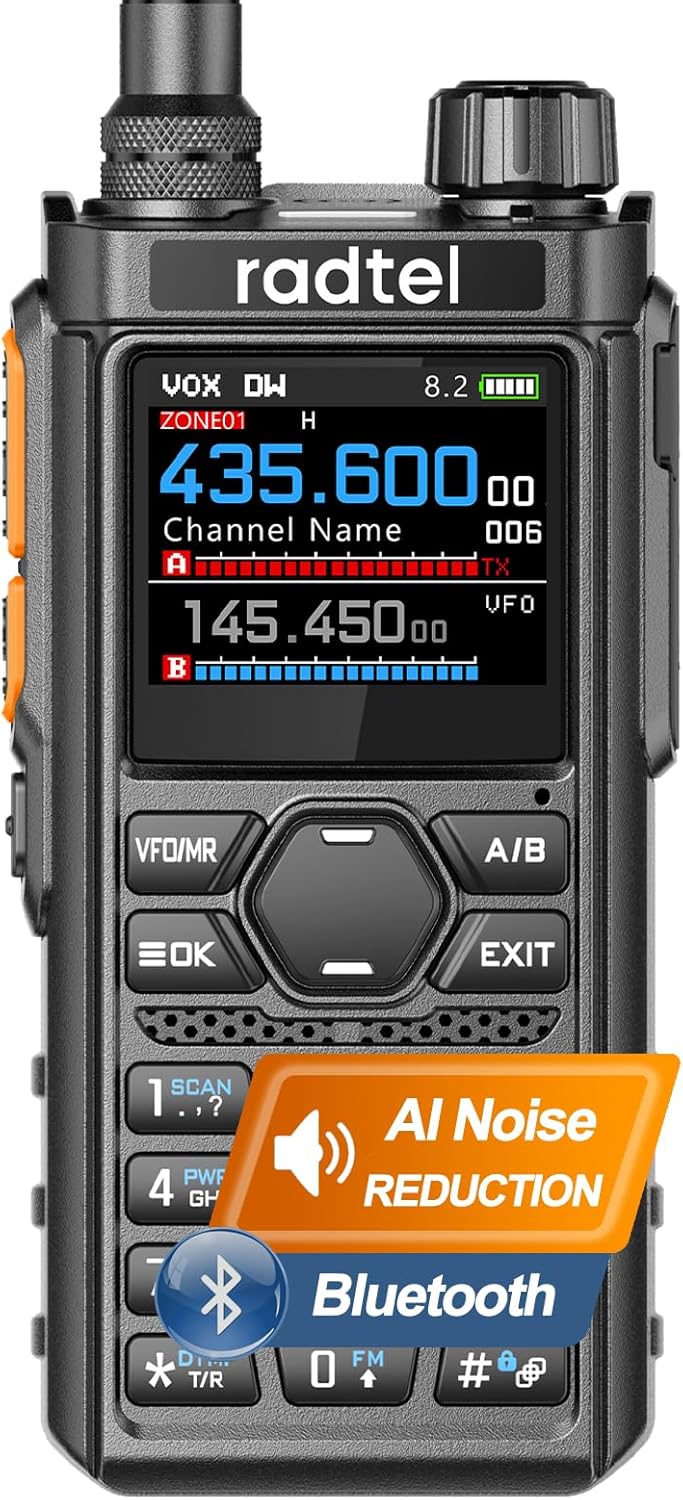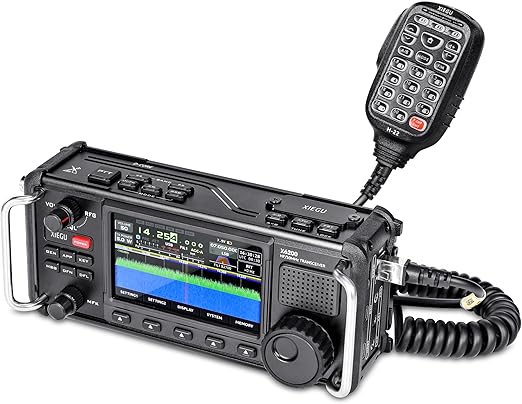
Overview
The Radtel RT-910B is a compact, feature-heavy handheld aimed at amateur radio operators who want a versatile, budget-friendly rig. It packs multi-band coverage including the 6 meter amateur band, up to 5 watts transmit power, a large channel capacity (960 channels), AM/FM broadcast receive, Type-C charging, spectrum scan, and Bluetooth support. On paper it looks like a Swiss Army knife for hams who want one radio that does a bit of everything: local simplex, repeater work, shortwave-ish monitoring, and casual scanning. This review walks through the hardware, ergonomics, audio, RF performance, usability, programming options, battery life and charging, Bluetooth and accessories, plus who will get the most from this radio.
What it is good for
-
Hams who want multi-band flexibility without carrying several radios.
-
Newcomers who want many features for a modest price and who are comfortable learning some radio basics.
-
Portable operators and casual park/picnic use where 5W and a compact form factor matter.
-
Users who want AM/FM broadcast listening and a built-in scanner/spectrum function.
-
Anyone who values modern conveniences like USB-C charging and Bluetooth headset support.
What it is not
-
A substitute for a full-power base station or contest-grade transceiver.
-
The best choice for serious weak-signal work, long-distance DXing, or high-performance contesting.
-
A replacement for radios with extensive aftermarket support, custom firmware, or world-class receiver performance.
Build quality and design
The RT-910B follows the now-common handheld stylistic template: a rugged-looking ABS/polycarbonate housing, a rubberized grip area, a detachable antenna, and a top-mounted rotary or button control for volume and channel selection. The chassis feels reasonably solid for the price point; seams are tight and buttons have a positive feel, though they’re not as crisp as midrange handhelds from legacy brands. The radio usually ships with a removable belt clip and a basic antenna; higher performance or longer antennas will improve transmit and receive noticeably.
Ergonomics and controls
Controls are laid out to be usable by one hand: a push-to-talk (PTT) on the side, programmable function keys, and a front-facing keypad for direct channel entry and quick menu access. The menu system is typically layered but logical — expect a learning curve if you’re used to simpler consumer radios. The display is clear enough for channel info, frequency readout, and menu navigation; backlighting helps in low light but is not overwhelmingly bright. The keypad and soft keys work fine with gloved hands if the gloves are not too bulky.
Display and user interface
The radio’s display presents frequency, mode (FM/AM), channel number, and status icons for battery, Bluetooth, lock, and scan. Spectrum scan functions usually show a waterfall or bar display to let you visually locate active signals — useful for newcomers and for chasing activity on less-commonly used bands like 6 meters. The channel memory system (up to 960 channels) is powerful: you can store repeaters, offsets, tones, and custom names — a strong point for portable operation and for users who hop between many repeaters.
Receiver and audio performance
For typical on-the-air use the receiver is serviceable. Sensitivity and selectivity are adequate for local repeater work and casual monitoring, though it won’t match the front-end filtering or DSP of higher-end transceivers. The inclusion of AM and FM broadcast receive expands utility for monitoring local news or propagation beacons. The speaker gets loud enough for noisy outdoor environments; audio is clear at reasonable volume levels but shows compression and distortion at extremes. Bluetooth audio output is handy for headset use, but expect slightly higher latency and compressed audio quality compared with wired headsets.
Transmit performance and power
The RT-910B is rated up to 5 watts on transmit, which is typical for handheld ham radios that allow QRP/low-power operation and still provide usable range into repeaters. Users should verify actual transmit power for each band/mode and expect that HTs with stock antennas and 5W will perform like other handhelds — excellent for local contacts and repeater access, limited for long-distance simplex unless propagation is favorable. The dual-PTT feature (if present) is useful for quick switching between channels or for linking talk groups in certain setups.
Antenna and RF considerations
Performance out of the box depends heavily on the supplied antenna. Stock antennas favor compactness over efficiency; swapping to a higher-gain, longer whip or using a mag-mount on a vehicle will substantially improve both transmit and receive. Because the radio covers multiple bands (including 6 meters), using band-appropriate aftermarket antennas for 6m, 2m, and 70cm will yield the best results.
Programming, memory, and features
The RT-910B’s 960-channel memory system is one of its headline features. It supports channel naming, offsets, CTCSS/DCS tones, and priority scanning. Many users will want to program channels via software (PC programming using a compatible cable and CHIRP-like formats where supported); if the radio supports CHIRP or vendor software, that makes bulk programming much easier. The spectrum scan function helps identify active frequencies quickly; it’s a great learning tool and simplifies finding local repeaters and beacons on the 6 meter band. Other useful features often include dual-watch, priority channel, VOX (if present), and adjustable power settings (high/low).
Bluetooth version and capabilities
The Bluetooth version adds convenience: wireless headsets, earpieces, and possibly wireless programming or phone link depending on implementation. Expect standard Bluetooth audio profiles that allow voice routing to a headset; Bluetooth will be handy for hands-free operation but is not a replacement for wired, low-latency connections in high-demand environments. If the radio supports Bluetooth PTT through an accessory, that can be a useful field addition.
Battery life and charging
Type-C charging is a modern convenience and means you can top up the battery almost anywhere without hunting for a proprietary charger. The stated battery capacity (if listed by the manufacturer) will determine real-world runtime; with moderate use a mid-sized battery often yields a full day of casual operation, while heavy scanning, Bluetooth streaming, or continuous transmit will shorten runtime quickly. Fast top-ups via USB-C are convenient in the field. If the radio supports external power via USB-C while transmitting, verify voltage/current specs to avoid charger overheating or insufficient power during transmit.
Accessories and expandability
-
Upgraded antenna: highly recommended for real improvement.
-
Desktop/charging cradle: handy if offered.
-
Programming cable and PC software: essential for bulk memory management.
-
External mag-mount or mobile adapter: if you plan to use the radio in a car.
-
Spare batteries for extended outings.
Usability in real-world scenarios
-
Repeater use: Excellent for accessing local repeaters thanks to programmable memory, tone support, and decent receiver sensitivity.
-
Simplex contacts: Works well for line-of-sight, especially with a better antenna.
-
Field-portable/POTA: Lightweight and feature-rich, especially with Type-C charging and Bluetooth headset.
-
Monitoring AM/FM: Adds entertainment and local broadcasting capability when you’re waiting between contacts.
Pros
-
Multi-band coverage including the 6 meter band.
-
Large channel memory (960 channels) for repeaters, simplex frequencies, and scanning playlists.
-
AM/FM broadcast receive adds general utility.
-
Modern conveniences: Type-C charging and Bluetooth support.
-
Compact, lightweight, and feature-rich for the price point.
Cons
-
Build and button feel are not the premium level of legacy high-end brands.
-
Receiver and audio quality are good but not class-leading—limited selectivity on crowded bands.
-
Out-of-the-box antenna usually limits real-world range; upgrade recommended.
-
Bluetooth audio is convenient but usually compressed and slightly latent compared to wired.
Tips and recommended settings
-
Replace the stock antenna early — you’ll notice an immediate improvement.
-
Program repeaters, offsets, and tones into memory before field use. Bulk programming via PC is faster and reduces mistakes.
-
Use the spectrum scan to find active spots on 6 meters before relying on memory channels.
-
Keep Bluetooth off if you need the lowest latency or best audio clarity for monitoring weak signals.
-
Carry a spare battery or powerbank for long outings; USB-C top-up from a powerbank is very convenient.
-
Learn how to lock keys and set backlight timeout to prevent accidental channel changes.
Who should buy it
-
New hams wanting many features at a modest price.
-
Portable operators who value light weight and battery convenience.
-
Casual users who want AM/FM listening plus a capable ham handheld.
-
Hams who want an inexpensive multi-band backup radio with modern features like Type-C charging and Bluetooth.
Who might skip it
-
Contesters, DX chasers, and weak-signal enthusiasts who require top-tier receiver performance and advanced filtering.
-
Operators who demand best-in-class ergonomics, proven long-term firmware support, and extensive aftermarket accessories.
Final verdict
The Radtel RT-910B brings together an appealing set of modern features into a single, compact handheld: multi-band coverage with 6 meters, 960 programmable channels, AM/FM receive, spectrum scanning, Bluetooth, and USB-C charging. For the price-conscious operator or the newcomer who wants to experiment across bands and modes, it’s a strong value proposition. Expect solid—but not exceptional—RF performance and build quality; the radio shines when paired with a better antenna and a bit of programming work. If you want a versatile daily carry or a capable backup HT with modern conveniences, the RT-910B deserves serious consideration. If, however, you need the absolute best receiver performance, premium buttons and knobs, or professional-grade durability, look to higher-tier models from long-established manufacturers.







